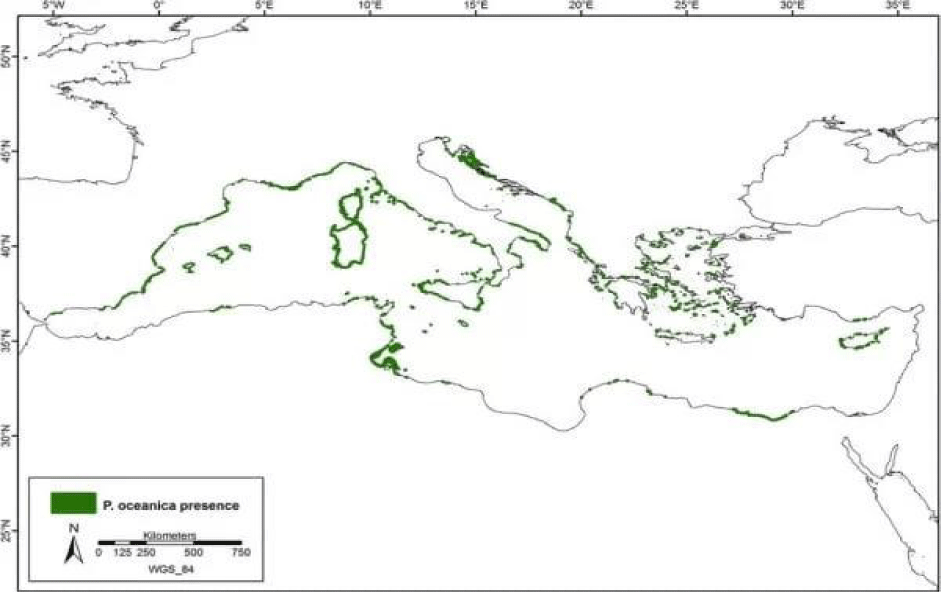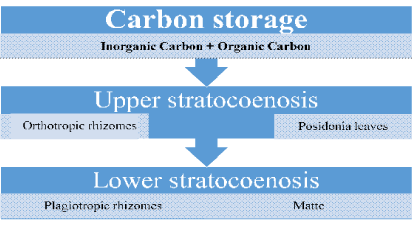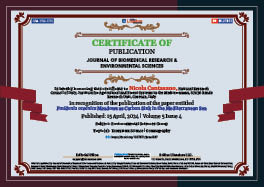Environmental Sciences Group. 2024 April 15;5(4):307-311. doi: 10.37871/jbres1897.
Posidonia oceanica Meadows as Carbon Sink in the Mediterranean Sea
Nicola Cantasano*
- Posidonia oceanica
- Carbon dioxide
- Carbon sink
- Climate change
- Mediterranean Sea
Abstract
Posidonia oceanica in one of the most important endemic species of Mediterranean Sea. In pristine coastal seawaters, it forms extensive meadows on mobile and hard substrata. Posidonia beds provide a lot of ecological roles and, amongst them, there is new ecosystem service known as “Blue Carbon”. This important function is the potential, performed by the meadows, to reduce the increasing concentration of carbon dioxide in the terrestrial atmosphere, binding it as organic matter in the leaves of the plants and, also, in the sediment of this valuable ecosystem. This study aims to assess the process of carbon sequestration performed by Posidonia beds and the dynamics of carbon storage through the different levels of the meadows.
Introduction
Posidonia oceanica (Linnaeus) Delile is a marine plant belonging to the division of Angiospermae and to the class of Monocotiledonae. This taxon, representing one of the most important endemic species of the Mediterranean Sea, can form in pristine coastal waters large and extensive meadows from 1 to 40 meters depth, according to sunlight conditions. Posidonia oceanica meadows grow on mobile and hard substrata within the euphotic coastal zone where represent the typical “climax” ecosystem in the infralittoral bottoms of the basin [1]. In the Mediterranean, Posidonia beds cover a total surface area between 2.5 and 5.0 million of hectares [2], while the shallow praires, from surface bottoms to 25 meters depth reach a total coverage area of 1.9 million of hectares for a seabed area of 56.783 km2 [3] (Figure 1).
However, in these last decades it is possible to observe a progressive regression of the meadows variable between 13% and 50% in regard to the values recorded on 2000 year [5]. So, to protect such important marine ecosystem, already described as “Priority habitat” according to the European Directive, it has been included as “Best Concern” in the Red List of the International Union for Conservation of Nature (IUCN) [6]. However, in spite of all the legislative efforts and the legal actions aimed to the protection of the species, it is possile to observe a gradual reduction of Mediterranean meadows, whose regression rate is variable between 13% and 50%, in regard to the values reported on 2000 year [5]. Indeed, the global warming of Mediterranean waters, as 1.5°C, compared to the pre-industrial levels of 1950’s, together with the low accretion rate of the meadows, as 1.0 cm/year [7], could increase this regressive trend [8]. Yet, Posidonia beds, even though it cover just 2.0% of Mediterranean bottoms, provide some important ecosystem services, highlighted by scientific literature [9-16]. These ecological roles can be summarized in the following points:
- High primary production.
- Great production of oxygen.
- Source of food and rest for faunal species.
- Area of reproduction and “nursery” for nektonic species.
- Consolidation of marine depths through the sedimentary roots of the plants able to compact loose substrata.
- Sink of nutrients and pollutants.
- Loop of nutrients.
- Purification of seawater through filtration.
- Sink of carbon dioxide.
This last fuction, known as “Blue Carbon”, was generally defined as the potential to sink the atmospheric carbon dioxide by marine ecosystems to reduce the effects of greenhouse gas emissions [17,18], that could bring about serious effects in the sructure of coastal ecosystems [19-21]. In particular, the meadows of Posidonia oceanica perform an important role sinking the atmospheric carbon dioxide [22]. This ecological role is, also, confirmed by experimental data according to which the meadows could be able to remove up to 42% of the carbon dioxide produced by Mediterranean countries [6]. These valuable ecosystems are, therefore, the greatest storage area in the Mediterranean Sea, representing one of the most important ecosystem services performed by the meadows with remarkable financial profits variabe between 7.7 and 230.0 Euros/hectare/year [3,15,23-25]. The carbon sequestration is realized both in inorganic than in organic forms in the upper and in the lower stratocoenosis of the meadows, respectively (Figure 2).
So, above the sediment, on the leaves of the plants, the inorganic carbon is stored over the short term, in decennial times, while under the sediment, at the base of the meadow, the organic carbon is stored over the long term, in millenial times [26-30] (Figure 3).
In particular, the storage of inorganic carbon is, partially, realized by epiphytes living on the leaves and on the orthotropic rhizomes of the plants where the inorganic carbon is converted in carbonates but most of the inorganic carbon is imported from some benthic habitats close to the meadows such as photophilic algal communities, coralligenous biocenosis and rhodolith beds [31-33]. At the same time, the organic carbon is sequestred by the thick sedimentary formation at the base of the meadow named “matte” [34] and composed by intertwined belowground rhizomes and by leaf sheats embedded in the sediment. Indeed, the amount of organic carbon adsorbed in the “matte” is variable between 6 and 175 gr. C/m2/year as the 10%-25% of the net primary production of the Mediterranean meadows [10]. In this way, Posidonia oceanica meadows are able to counteract the global emission of greenhouse gas, reducing the warming trend of mediterranean seawaters [16, 17,21,35-37]. Therefore, it is necessary a continous monitoring and an up-to-date mapping of Mediterranean meadows, not only for an effective management of this valuable marine ecosystem, but also to recognize potential adaptable strategies in a climate change scenario. In conclusion, Posidonia oceanica meadows could represent a new Nature Based Solution (NBS) against the gradual but steady increasing of carbon dioxide in the terrestrial atmosphere and, more generally against the negative effects of climate change.
Author Contribution
Conceptualization, NC, methodology, NC, software, NC, validation, NC, investigation, NC, data curation, NC, writing-original draft preparation, NC, writing-review and editing, NC, visualization, NC, supervision, NC. The author has approved and agreed to the published version of the manuscript.
Funding
This research received no external funding.
Institutional review board statement
Not applicable.
Informed consent statement
Informed consent statement was obtained from all subjects involved in the study.
Data availability statement
The data presented in this study are available on request from the corresponding author.
Conflict of interest
The author declares no conflict of interest.
References
- Bahl P, Doolan C, de Silva C, Chughtai AA, Bourouiba L, MacIntyre CR. Airborne or Droplet Precautions for Health Workers Treating Coronavirus Disease 2019? J Infect Dis. 2022 May 4;225(9):1561-1568. doi: 10.1093/infdis/jiaa189. PMID: 32301491; PMCID: PMC7184471.
- Khan MM, Parab SR. Simple Economical Solution for Personal Protection Equipment (Face Mask/Shield) for Health Care Staff During COVID 19. Indian J Otolaryngol Head Neck Surg. 2022 Oct;74(Suppl 2):2676-2680. doi: 10.1007/s12070-020-01863-4. Epub 2020 Apr 27. PMID: 32346531; PMCID: PMC7185905.
- de Perio MA, Dowell CH, Delaney LJ, Radonovich LJ, Kuhar DT, Gupta N, Patel A, Pillai SK, D'Alessandro M. Strategies for Optimizing the Supply of N95 Filtering Facepiece Respirators During the Coronavirus Disease 2019 (COVID-19) Pandemic. Disaster Med Public Health Prep. 2020 Oct;14(5):658-669. doi: 10.1017/dmp.2020.160. Epub 2020 May 19. PMID: 32423515; PMCID: PMC7303467.
- 3M. Quantitative fit testing of respirators. Technical Bulletin. 2021.
Content Alerts
SignUp to our
Content alerts.
 This work is licensed under a Creative Commons Attribution 4.0 International License.
This work is licensed under a Creative Commons Attribution 4.0 International License.











